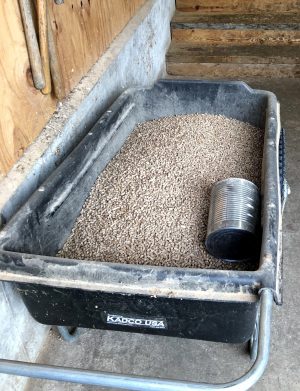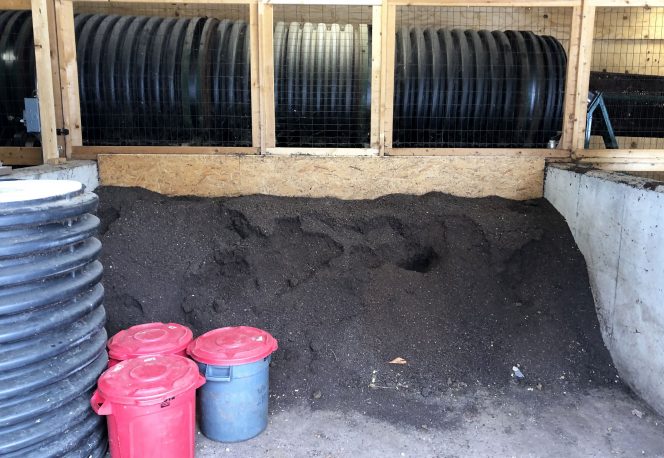A low-tech rotary drum composting unit to compost food waste is in use at several schools. The design is free to download.
Bob Spencer
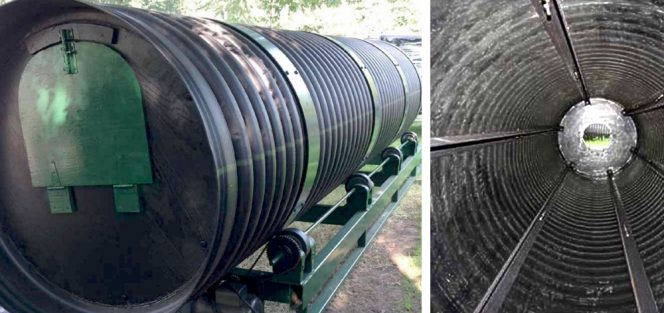
The exterior and interior of a completed drum using North Country School’s design. Images courtesy of North Country School
Food waste is composted by a wide range of technologies, from low-tech windrows that require only a front-end-loader to mix and turn piles, to medium-tech aerated static piles and windrow turning machines, to high-tech in-vessel containers with aeration and agitation systems. The guiding principle of higher tech equipment design is to maximize the presentation of surface area of the food waste to microbes within optimal oxygen and moisture concentrations, thus accelerating degradation.
Rotary drums are at the high end of the technology spectrum since they continuously, or intermittently, mix food waste with carbon bulking agents such as leaves, wood chips, and nonrecyclable paper and cardboard. Large rotary drums can be 12-feet in diameter and 185-feet long, with a capital cost of more than $2 million per drum. There are also smaller drums, such as 4-feet in diameter and 8-feet long, or 10-feet in diameter and 40-feet long. The capital cost of such systems can be $40,000 to more than $150,000.
Rotary drums have been successfully utilized to compost food waste in all kinds of settings, from municipal to universities to an automobile manufacturing facility. There are probably more than 100 smaller drums operating on dairy farms in North America that convert manure into compost, as well as bedding for the cows. Drums are also used to compost animal mortalities, particularly chickens.
Less Expensive Design
Since its inception in the 1920s, the North Country School/Camp Treetops (NCS/CTT) preparatory school for students in grades 4 through 9 in Lake Placid, New York, strives to connect students to the land through environmental studies and outdoor education, forestry, organic gardening, hiking, skiing, swimming, and other activities so prevalent in the Adirondack mountains. Food scraps have been composted since the 1940s at the school and summer camp, with compost used to grow vegetables in greenhouses and gardens for the cafeteria.
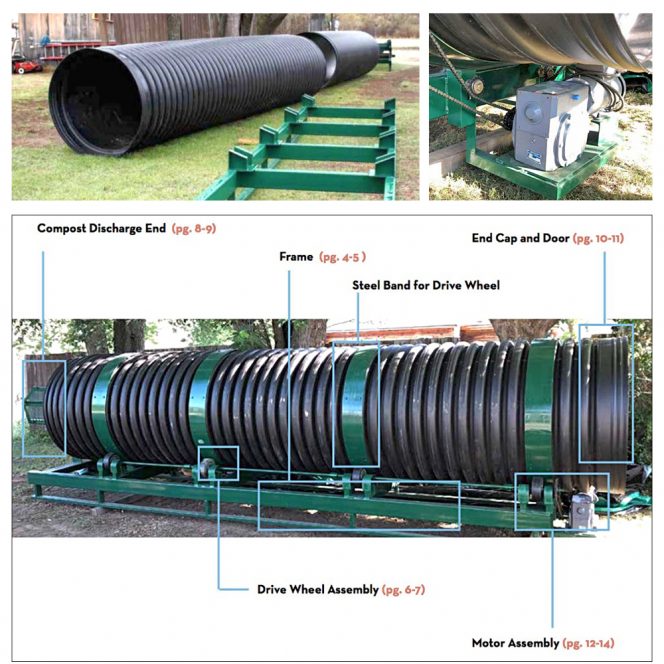
Major components of the North Country School’s rotating composting drum design include the drum itself, made from HDPE culvert, and the frame (top, left) and drive system (top, right). The North Country School’s “Rotating Drum Composter Design Guide” illustrates components and stages of construction as well as part numbers and dimensions. Images courtesy of North Country School
To divert more food scraps from landfill disposal, John Culpepper, Director of Facilities and Sustainability at NCS/CTT, worked with Greg LeClair, a longstanding contractor for NCS/CTT, to design and build an in-vessel composter that would accelerate the composting process despite Lake Placid’s cold winters, and be cost-effective for the school. Jennifer Perry, Energy Circuit Rider with the Adirondack North Country Association, assisted Culpepper in preparing a grant application to the New York State Energy Research Development Authority in 2014 to design and construct a pilot rotary drum composter. The prototype drum was installed in a 3-bay garage building in 2016, and has operated successfully since then.
Culpepper and LeClair built the rotary drum using a 4-foot diameter, 20-foot long double walled polyethylene road culvert, an electric motor with gear reduction, and a series of 8 wheels durable enough to hold up under the weight of the food waste (up to 3,300 pounds when at capacity). Materials were about $15,000, and Culpepper estimates a several year return on investment, depending on labor and landfill disposal costs.
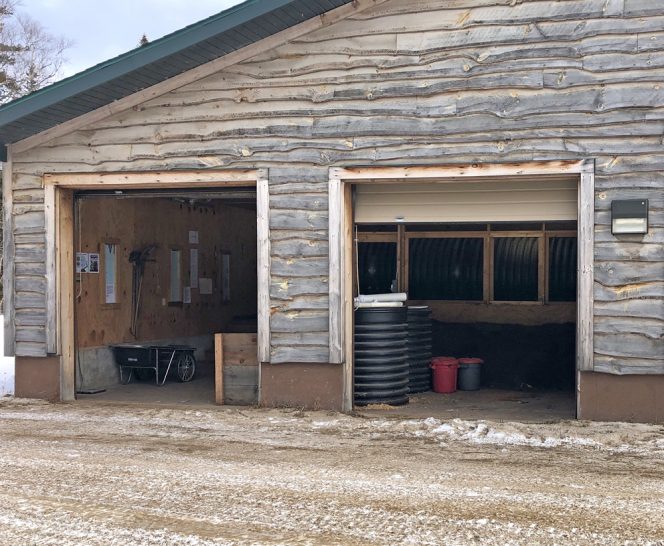
Exterior of garage at North Country School that has been retrofitted for drum installation (visible inside right-hand door). Photo by Bob Spencer
With the food waste ban disposal passed last year in New York State, he wanted to develop a design that could be replicated by other institutions. “We want to make this design available to others who have the capability of constructing their own drum,” notes Culpepper. Design plans, an operating manual, and other supporting materials are free to anyone and can be accessed on the North Country School website.
Drum Operations
The school feeds approximately 150 persons, 3 times per day, generating approximately 65 pounds (lbs)/day of food scraps. On a daily basis, 3 students and an adult supervisor carry buckets of food scraps to the composting building. They manually chop larger pieces such as oranges into smaller pieces, and then mix food scraps with wood pellets. NCS/CTT’s recipe is 0.275 lbs of wood pellets for each pound of food waste. For 100 lbs of food waste, 27.5 lbs of wood pellets are mixed in.
All students are encouraged to assist with the composting drum. During the summer when Camp Treetops is operating, the quantity of food waste generated can more than double to 125 lbs/day. “I generally tell people that a good average amount for this unit is 100 lbs/day of food scraps when using their composter seven days/week throughout the year, although it easily handles 400 lbs/day on occasion,” says Culpepper. He adds that the unit composts approximately 30,000 lbs/year of food waste, mixed with 8,000 lbs of wood pellets, which are consumed in the composting process.
The drum is operated approximately half-full, and has a retention time of 25 to 45 days depending on how much is loaded. After being in the drum, the compost can be used for top dressing, however most is put into an adjacent bunker and further cured for several months, resulting in a stable compost that is used in vegetable and flower gardens on the campus. A small trommel screen was constructed to screen compost to half-inch for use in the school’s greenhouses.
A latching door is opened at the feed end to load the food scraps mixed with wood pellets. For safety reasons, the drum motor is inside a locked box with a switch that must be held down for the drum to rotate. Only a supervising adult is allowed to access the control panel. The switch is held down until the drum makes several revolutions to mix in the daily batch. Students use a long-stem thermometer to measure the temperature of the mix at the loading end, and record the temperature on a daily basis. Recently, Culpepper has used temperature data loggers attached to whiffle balls to track temperature inside the drum, confirming that the process operates at 110°F to 140°F.
The drum is sloped approximately 3 inches over its 20-foot length to move material through the unit. There are 6 rows of 3-inch by 3-inch angle irons bolted through the drum, which gives the drum rigidity and lifts material to fluff it as the drum turns. No blowers are used to move air through the drum; natural convection through both ends of the drum keeps the contents aerobic.
Additional Installations
Three other schools have installed NCS/CTT rotary drums, housing them inside 40-foot long metal shipping containers to help retain composting temperatures in the drums. The schools are Lake Placid Central School, Hermon DeKalb Central School in upstate New York, and the Pingry School in Basking Ridge, New Jersey. The fifth facility is at the Wild Center in Tupper Lake, an Adirondack natural history center.
Culpepper and LeClair estimate that increasing the diameter of the drum to 5 feet will increase its throughput capacity significantly. They are seeking grant funding to construct and demonstrate a larger vessel.
Bob Spencer is a Contributing Editor to BioCycle.



